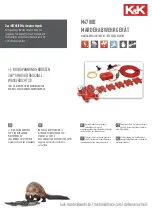
4
OPERATING TEST
Block vehicle and hold by means other than vehicle brakes.
Charge air brake system to governor cut-out pressure.
1. Place parking control valve in “park” position. Observe
that spring brake actuators apply promptly. Remove
one line from delivery port of valve and install test gauge
known to be accurate. Place parking control valve in
“release” position. Observe that spring brake actuators
release fully.
2. With parking control valve in “release” position, note
gauge pressure reading. (Check vehicle manual for
correct spring brake actuator hold-off pressure.) If
pressure reading is incorrect, modulating valve should
be adjusted. (See section “Adjustment of Modulating
Valve - Spring Brake Actuator Hold-Off Pressure”.)
3. Place parking control valve in “park” position - gauge
reading should drop to zero promptly. A lag (more than
1 second) in drop of pressure would indicate faulty
operation of the single check valve (within the modulating
valve).
4. With the parking control valve in the “park” position fully
apply foot brake valve several times and note a pressure
reading increase on the gauge each time the brake is
applied. If pressure reading does not occur, the
modulating valve requires servicing or replacing.
5. Place parking control valve in “release” position.
Determine the reservoir which supplies balance port and
drain completely.
Apply foot brake valve several times and note that pressure
reading on gauge decreases each time foot brake valve is
applied. After foot brake valve has been applied several times,
pressure on gauge will drop to the point where release of the
spring brake actuators will no longer occur.
LEAKAGE TEST
Place the park control valve in the “release” position; using
a soap solution, coat exhaust and vent hole (in proximity of
adjusting screw). Slight bubble leakage permitted.
If the valve does not function as described, or if leakage is
excessive, it is recommended that it be repaired or replaced
with a genuine Bendix service replacement valve.
ADJUSTMENT OF MODULATING VALVE - SPRING
BRAKE ACTUATOR HOLD-OFF PRESSURE
Block vehicle by means other than vehicle brakes. If it has
been ascertained that hold-off pressure for the spring brake
actuators is incorrect (see section “Operating Test”),
adjustment should be made as follows:
1. Build system pressure to governor cut-out
(approximately 120 psi). It is important that system
leakage for a single vehicle not exceed a 2 psi drop in
one (1) minute with brakes released. Correct system
leakage before proceeding with adjustment.
2. Place parking control valve in “park” position and install
an accurate test gauge in a delivery port of the
modulating valve. Place parking control valve in “release”
position and observe pressure reading on the test gauge.
Refer to vehicle manual for recommended pressure.
Adjust as necessary.
TO RAISE HOLD-OFF PRESSURE
Loosen lock nut. Turn adjusting screw clockwise and observe
reading on gauge. To raise hold-off pressure, turn adjusting
screw clockwise - to lower hold-off pressure, turn adjusting
screw counterclockwise until pressure is below that desired
and then turn screw clockwise to desired pressure. Tighten
locknut securely after completing adjustment.
DISASSEMBLY
1. Remove exhaust cover screw, exhaust cover and
exhaust diaphragm.
2. Remove four (4) cap screws and lockwashers and cover.
Remove o-ring from cover.
3. Remove control piston and remove three (3) o-rings from
control piston.
4. Remove large retaining ring from body and remove inlet/
exhaust valve assembly.
5. Remove ring from inlet/exhaust valve assembly. Remove
o-ring retainer, remove o-ring from o-ring retainer.
Remove washer and spring. Remove valve retainer and
valve from valve body.
6. Remove four (4) cap screws from other cover. (Do not
disturb center cap screw unless spring brake hold off
pressure is to be adjusted). See Section “Adjustment
of Modulating Valve”.
7. Remove cover and inner and outer springs.
8. Remove balance piston. Remove o-ring from balance
piston.
9. Remove retaining ring from supply port and remove
supply adapter and double check valve assembly.
Remove o-ring from supply adapter. Remove double
check valve from shuttle guide. (NOTE: To ease removal
of supply adapter, a pipe nipple can be screwed in
adapter.)
10. Remove allen head plug from single check valve service
port. Remove single check valve assembly. (If single
check valve is difficult to remove, it can be dislodged
inside bore of body of valve).
























